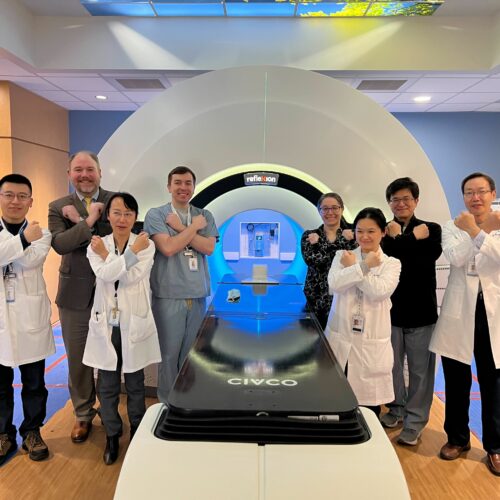
Metastatic Cancer
Understanding Radiotherapy Part 2: How Much Radiation is the Right Amount?
May 16, 2019
This week’s post will build upon what we learned in our last entry, which reviewed the basics of radiotherapy. I highly recommend reading that post if you have not already, but a very quick summary is that radiotherapy can be thought of as shooting billions of tiny bullets at cancer cells, causing those cancer cells to undergo internal injuries to their DNA, resulting in their death. We also discussed several ways that physicians can make radiotherapy gentler on normal tissues in the body such as the use of fractionation to split the dose into small pieces and precision to concentrate the beam more on tumors and less on surrounding healthy tissue.
A natural question that comes next is: How much radiation should we deliver to the tumor? Since radiation dose is measured in a unit called Gray (abbreviated as Gy), a different way of asking the question is: How many Gray of radiation does it take to treat a tumor successfully? Although it is tempting to think about dosing in the same way we do with drugs, which usually mandates a standard milligram dose with a standard schedule for an adult patient, it turns out that dosing radiation is quite a bit more complicated. Radiation dosing must take into account a number of factors including the goals of the physician, the tumor being treated, the amount of fractionation (splitting the dose) planned, the presence of nearby organs, and whether chemotherapy or immunotherapy is being given at the same time. Suffice it to say that much of the residency training for radiation oncology involves navigating this complex maze of considerations to pick the right dose for the patient sitting in front of you!
In fact, if you walk into a radiation clinic on an arbitrary Wednesday, you are likely to see an incredibly diverse set of doses for the patients being treated that day. You may see:
- Stage I lung cancer: 54 Gy total given over 3 sessions
- Stage III lung cancer: 60 Gy total given over 30 sessions
- Stage I breast cancer: 40 Gy total given over 15 sessions
- Stage IV prostate cancer, spread to the bone: 8 Gy total given over 1 session
It is not easy to wrap one’s mind around these seemingly haphazard numbers, especially since we would not expect five adults to get five different doses and schedules for Tylenol or Penicillin.
How do radiation oncologists make sense of these numbers? First, it is important to note that both the total dose and the dose-per-fraction influence the overall intensity of the treatment. In fact, there is a formula that takes these two factors and computes a single number that quantifies the overall strength of the treatment. For instance, this formula predicts that for breast cancer, giving 45 Gy over 25 sessions is about equal to giving 40 Gy over 15 sessions. In other words, even if radiation clinic A uses the first combination of dose and session number while radiation clinic B uses the second combination, the overall effect of the treatment on the cancer is the same in both cases.
Once we convert our dose/fraction combination into an “overall effect” value, the next way to aid our understanding of radiation doses is to divide the range of those values into three tiers: “Definitive,” “Adjuvant,” and “Palliative.” Definitive radiotherapy represents the top of the range and refers to the clinical situation where the physician is seeking to get rid of the tumor for good. The general principle for definitive radiotherapy is to give as much radiation as it takes to maximize the probability of killing every last cancer cell in that tumor. This typically requires either a high total dose, a high fraction size, or both. Sometimes a definitive treatment requires going up to the limit of what the normal tissues around the tumor can handle, which can make for a long treatment with more side effects. If you have a family member or friend who underwent definitive radiotherapy for prostate cancer, you may have learned that the treatment required 7 or 8 weeks of daily therapy. Thankfully, as we mentioned in a prior post, a general trend has been to use precision technology to give more dose per session safely, which means that even definitive radiotherapy courses are moving toward shorter commitments of time.
The second category, called “adjuvant,” represents the middle range of treatment intensity. This word comes from Latin and means “to help.” This label refers to the fact that radiation is used in these cases to help another therapy, which is usually surgery. The idea here is that surgery may remove a visible tumor, but that roots and stray cancer cells can be left behind. A middle intensity of radiation is quite effective at clearing out these leftovers after many cancer surgeries. The most common example of this is in early-stage breast cancer, where a surgeon removes the lump of cancer and a medium dose of radiation is delivered to the remaining breast tissue to clear any leftover cancer cells. You can take or leave these analogies, but many of my patients used words like “fumigating” or “sterilizing” after the surgery to help them understand what adjuvant radiotherapy was doing.
Palliative radiotherapy refers to the lowest part of the intensity range. In these cases, it is not the physician’s intent to completely eradicate a tumor (as in the definitive setting) or to comprehensively clear out microscopic leftovers (as in the adjuvant setting). Rather, palliative radiotherapy is meant to improve the life of the patient by shrinking a tumor that is causing the patient to suffer. Usually, a low dose of radiation is adequate to shrink a troublesome tumor and relieve a symptom like pain or bleeding. Furthermore, these low doses of radiotherapy have minimal side effects and can be delivered over short, convenient timeframes, so that the patient can spend less time in therapy and more time with their loved ones.
These categories are a helpful way to think about radiotherapy in all the different contexts that it is used, both alone and in combination with other treatments. This framework also helps us understand how one treatment can have the versatility to treat different cancers and across different stages of disease. In fact, more than 50% of cancer patients can benefit from radiotherapy at some point in their treatment course (1). Sadly, many patients who need radiotherapy do not have access to it, and this occurs in both advanced and developing countries. For instance, among European countries, one out of every four patients who need radiotherapy do not have access to it (2). And the situation is even worse in lower and middle income countries; one report found that only 4 out of 139 of these developing countries had enough radiotherapy units to meet the needs of their population (3). Indeed, making sure that effective, affordable, life-saving radiotherapy is available to all the patients who need it is one of the major global population health challenges of our generation.
To round out our understanding of radiation dosing, there are two additional details worth mentioning. The first is that every cancer type has its own sensitivity to radiation. Some cancers, like lymphoma, are very vulnerable to radiation, while others, like soft tissue sarcoma, are relatively resistant. Therefore, a total dose and fraction size that can treat lymphoma definitively may only treat sarcoma palliatively. As it happens, radiation oncologists have a good understanding of how different types of cancer respond to radiation based on decades of trying different doses in the laboratory and in clinical trials. However, once we narrow it down to a specific type of cancer – again, like lymphoma or soft tissue sarcoma – the tendency is to use a one dose fits all approach. An exciting area of research is to determine whether we can extract how sensitive a tumor is to radiation using its genetic profile. This could allow us to personalize radiation dosage for each individual patient, allowing some patients to get by with less dose and fewer side effects, while other patients could be offered more radiation because their tumors require additional intensity.
The other interesting detail is that giving drugs like chemotherapy at the same time as radiation can enhance the intensity of the radiation. This is helpful for situations where the highest dose of radiotherapy that can be safely given is not quite enough to reliably kill every last cancer cell in a tumor. Giving chemotherapy in these situations can boost the radiotherapy intensity enough to get the patient over the line. Certain stages of head-and-neck cancer, lung cancer, and gynecologic cancers are situations where the combination of chemotherapy and radiation is routinely used to give patients their best chance at a cure. Also, at the risk of sounding like a broken record, this is another area where a better understanding of a tumor’s biology and genetics could help us guide treatment more precisely for each individual. (“Joe’s lung cancer needs a combination of chemotherapy and radiation, but Marta can expect good results for her lung cancer with radiation alone.”)
Because this series is focused on metastatic cancer, it is worthwhile to end on how this discussion of radiotherapy intensity relates to patients with stage 4 disease. For most of oncology’s modern history, the only intensity of radiotherapy that was recommended in patients with metastases was the palliative kind, directed at one of the sites of disease to help alleviate symptoms. This made sense based on the prevailing understanding of cancer: It was argued that if tumors had already spread around the body, it would be overkill to treat any one of those tumors with a longer course of definitive radiotherapy. The strong belief was that definitive radiotherapy was useful in early stages of disease, but it could not add much benefit once the “cat was out of the bag.” As I’ve alluded to in prior posts, new reports published in just the last two years have radically challenged this understanding. In the next post, we will discuss how new technology is helping physicians to really test these dogmas. I hope you will join me as we learn more about the highly promising approach of incorporating definitive radiotherapy into treatment for metastatic cancer patients .
Refs.
(1) Delaney G, Jacob S, Featherstone C, Barton M. The role of radiotherapy in cancer treatment: estimating optimal utilization from a review of evidence-based clinical guidelines. Cancer. 2005;104:1129–1137.
(2) Borras JM, Lievens Y, Dunscombe P, et al. 2015. The optimal utilization proportion of external beam radiotherapy in European countries: An ESTRO-HERO analysis. Radiother Oncol 116(1): 38-44
(3) Datta NR, Samiei M, Bodis S. Radiation therapy infrastructure and human resources in low-and middle-income countries: present status and projections for 2020. International Journal of Radiation Oncology* Biology* Physics. 2014 Jul 1;89(3):448-57.





